
Ten Best Off-the-Beaten-Track Sights in Washington, D.C.
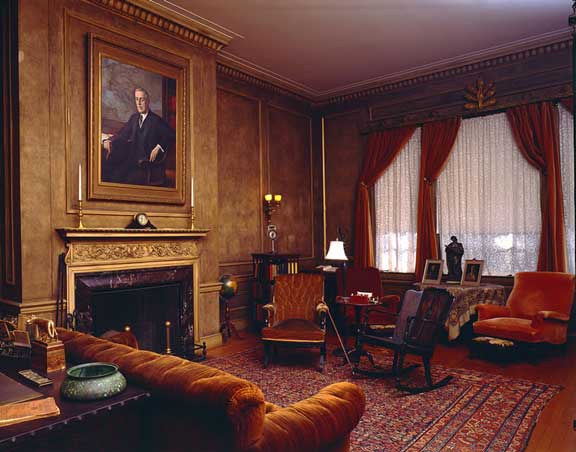
1. Woodrow Wilson House
This is one of the most authentic historic house museums in the country--everything that the Wilsons owned (other than his books) is still here, down to Wilson's socks in his dresser drawers. President Woodrow Wilson moved into this house directly from the White House after he left office in 1921, and he lived here until his death in 1924. His widow, Edith Bolling Galt Wilson, lived in the house until she died in 1961, when it became a museum. Wilson is the only U.S. president to live in Washington after he served, and the only one buried here--in Washington National Cathedral.
Inside the house, the furnishing are tasteful, beautiful, and full of interesting historical connections. What's better, the tour takes you away from the crowds--the groups are usually small, the guides are knowledgable, and you will see nearly the entire house. It's located in Kalorama, not far from the Dupont Circle Metro. The neighborhood is one of the best in D.C. for walking: there good restaurants, interesting shops, and beautiful old houses; and the Phillips Gallery of Art is only a few blocks away.
Address: 2340 S Street, N.W., Washington, DC 20008
Metro: Dupont Circle
Website: woodrowwilsonhouse.org
Photograph: The President Woodrow Wilson House, Washington, D.C.
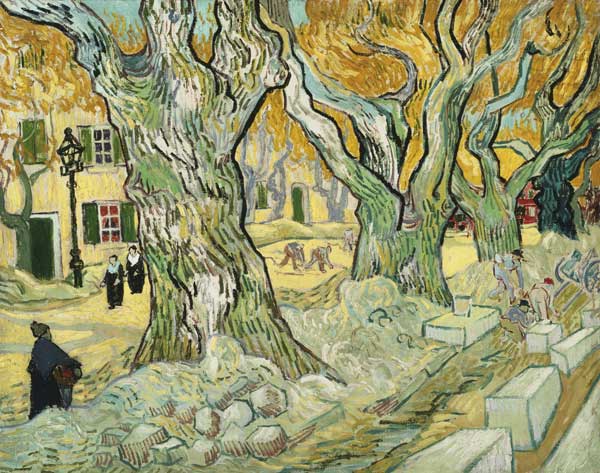
2. The Phillips Collection
This mid-sized art museum, in a nondescript building on a side street near Dupont Circle, is likely to be overlooked by visitors. That's a shame because it has the best collection of Impressionist paintings in Washington. The centerpiece is Luncheon of the Boating Party (1880-81) by Pierre-Auguste Renoir, widely acknowledged to be the greatest masterpiece in the city. There are paintings by Gauguin, Matisse, Picasso, John Sloan, Mark Rothko, and many others, including a stunning collection of works by Vincent Van Gogh. The collection opened to the public in 1921 and focusses on French Impressionism, Modernism, and contemporary art. As a bonus, the Phillips is located in one of the city's most walkable neighborhoods, only a few blocks from restaurants and coffee shops.
Address: 1600 21st Street, N.W., Washington, DC 20009
Metro: Dupont Circle
Website: phillipscollection.org
Photograph: Vincent van Gogh, The Road Menders, 1889. Oil on canvas, 29 x 36.5 in. Acquired 1949. The Phillips Collection, Washington, D.C.
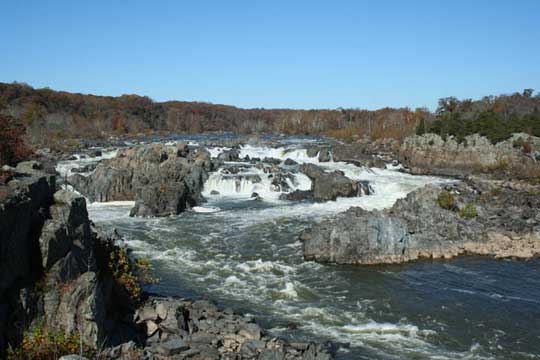
3. Great Falls
Great Falls is the premier natural wonder in the Washington, D.C., area. At the falls, the Potomac River drops 76 feet and flows through the narrow and rocky Mather Gorge. Located in a national park 15 miles north of town, it's a perfect place to get out of the city and get some exercise in a beautiful setting. The Virginia side of the river is in Great Falls Park, while the Maryland side is in the Chesapeake and Ohio Canal National Historic Park. There is no way to cross the river near the falls, so you will have to pick your side. Both sides are nice, but the Virginia side has a visitor center and better views of the falls. Parking at Great Falls Park can be difficult on some weekends when the lot fills up and, at times, a long line of cars forms at the entrance. In any case, you may be able to find legal parking at adjacent parks and reach Great Falls on foot.
Besides the spectacular falls, there are miles of hiking trails, including a nice five-mile loop from the falls to Difficult Run and back. The latter is a creek that runs steeply down through boulders to the Potomac River at the southern edge of the park. Kayaking and rock climbing are popular sports, and there is history here as well: visitors can see remains of the Potowmack Canal, begun in 1785, which connected tidewater at Georgetown with the Ohio River. (The Potowmack Canal is not the same as the Chesapeake and Ohio Canal, begun in 1828, which is on the Maryland side of the river.) The visitor center has a snack bar, open seasonally, and exhibits about the park's rich history. One highlight is an 18th century African-style dugout canoe that was found in the mud far upstream, which was used by slaves to move goods between plantations.
Address: 9200 Old Dominion Drive, McLean, VA 22102
Metro: there is no public transportation near the park
Photograph: © Peter R. Penczer 2015
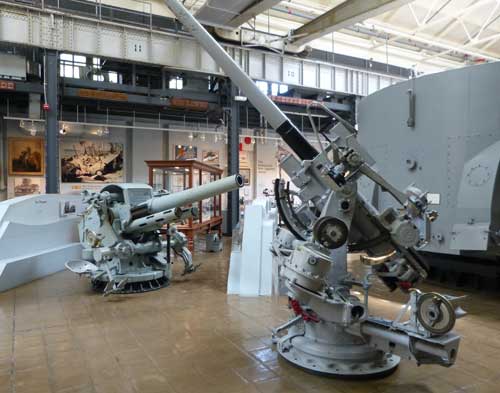
4. U.S. Navy Museum
This is the principal museum of the U.S. Navy and one of the oldest museums in the country, but its obscure location on a military base in Southeast Washington means that you may have the entire place to yourself. Security requirements for entering the base are constantly changing, so you are advised to call the museum in advance--information on the website is not necessarily accurate. Currently (October 2015), non-military visitors must check in at the O and 11th Street, S.E., gate, weekdays only, and pass a background check before they can walk to the museum! Parking on the base is difficult, so you should take the Metro or park off base.
Once at the museum, you will be impressed by a vast assemblage of objects, too much to see in one visit. Highlights are the Trieste, the first submersible to reach the bottom of Marianas Trench, and a section of a mast from the USS Kearsarge pierced by a shell from the CSS Alabama. There are wonderfully detailed ship models, some more than ten feet long, and too many to count. Of course, there is all sorts of equipment, uniforms, and weapons going back to the beginning of the U.S. Navy. The Navy Yard itself is of great interest, a virtual open-air museum of naval history. Established in 1799, it is the oldest U.S. naval base. Besides the historic buildings, there is an outside display of naval guns, a titanium diving bell, and more. Just outside the base on the Anacostia River Walk is John Kerry's swiftboat and the USS Barry, a Cold War-era destroyer. The latter is permanently closed however, and due to be scrapped.
Address: 11th and O streets, S.E.
Metro: Navy Yard (about 12 blocks distant)
Website:
history.navy.mil/museums/NationalMuseum/org8-1.htm
Photograph: © Robert Johnson 2013
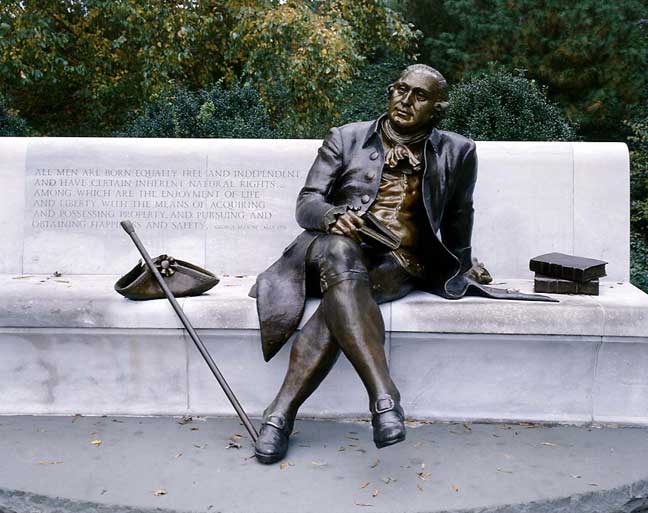
5. George Mason Memorial
This modest memorial is located across the street from the Jefferson Memorial, only a few steps off the beaten path. It may not be worth a voyage across the Atlantic, but its quality is far greater than its relative obscurity would suggest. Visitors will be rewarded by a close-up view of a sculpture of George Mason (1725-1792), who appears seated under a broad trellis holding a volume of Cicero in his hand. In a city full of figurative sculpture (some of it mediocre at best), this one by Wendy Ross is one of the best and superior to the statue of Thomas Jefferson nearby. George Mason was one of the Founding Fathers, albeit lesser known. He was a neighbor of George Washington and one of his intellectual mentors and, in 1776, he wrote the Virginia Declaration of Rights, which served as the basis for the Bill of Rights in the U.S. Constitution.
Address: East Basin Drive, about 200 yards southwest of the Jefferson Memorial, near the Potomac River
Metro: Smithsonian, 0.8 miles
Photograph: © Peter R. Penczer
6. Scottish Rite Temple
This building is one of the most beautiful, impressive, and interesting in Washington, D.C., but is off the normal tourist trail, no doubt due to its location out 16th Street. Visitation has, however, increased of late due to Dan Brown's best-selling book The Lost Symbol. The temple, which opened in 1915, is the principal building of Scottish Rite Masonry. The proportions are monumental and the quality is outstanding--inside, rare marbles and the arcane symbols of freemasonry are everywhere to be seen. Outside are two massive sphinxes by Adolph Weinman, sculptor of the pediment of the Jefferson Memorial.
Beyond the massive bronze doors is the atrium, where the grand staircase is guarded by two monumental black marble Egyptian eagles, also by Weinman. The stairs lead up to the Temple Hall, a domed room 100 feet tall that seemingly encompasses most of the building--at the center of which is the altar where the rituals of Masonry take place. There are also several museums, each somewhat eccentric and arcane, which include a rare book library and exhibits on Confederate General Albert Pike, who originated many of the masonic rites, and J. Edgar Hoover, also a mason. Tours are given on demand and, as there is too much to see on one tour, each can be different from the other.
Address: 1733 16th Street, N.W., Washington, DC 20009
Metro: Dupont Circle or U Street
Website: scottishrite.org/headquarters/about-the-temple
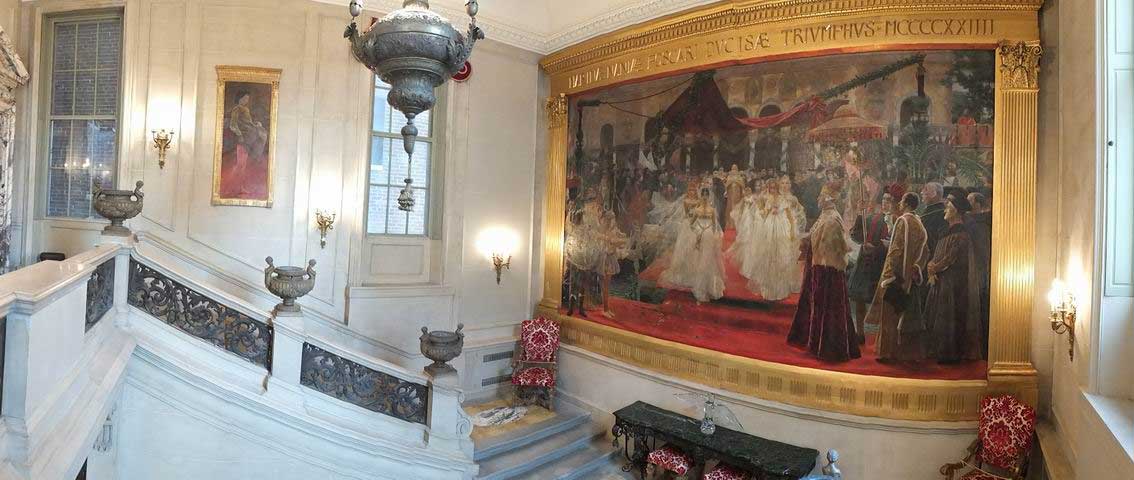
7. Anderson House
At the turn of the twentieth century, Washington, D.C., was the "winter Newport, a place where Gilded Age millionaires spent the city's social season. Many of their mansions survive on Massachusetts Avenue, N.W., and nearby streets, some now foreign embassies. One of most costly and imposing was the Anderson House. Completed in 1905, it is open to the public as a house museum, with regular tours. The house's 50 rooms are decorated in a variety of historical styles with antiques that once belonged to the Andersons.
Larz Anderson was a diplomat from a socially prominent family; his wife, Isabel, was an author and the heiress to a shipping fortune. After his death in 1937, she gave the house to the Society of the Cincinnati, of which Larz was a member, and it now serves as the society's headquarters. The Society of the Cincinnati is the nation's most exclusive hereditary organization, open only to certain male descendants of officers in the Continental Army or French forces who served during the American Revolution. Besides free tours of the house, the Society of the Cincinnati mounts changing exhibits related to the society and the Revolutionary War, and holds concerts and lectures.
Address: 2118 Massachusetts Avenue, N.W., Washington, DC 20008
Metro: Dupont Circle
Website: societyofthecincinnati.org
Photograph: © Bruce Guthrie
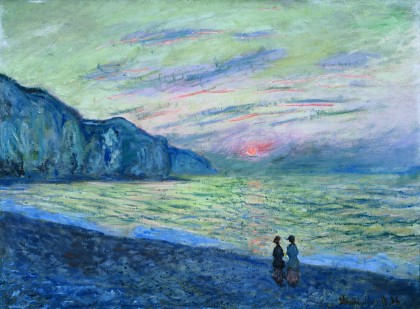
8. The Kreeger Museum
The Kreeger has a relatively small, but fine, collection of paintings dating from 1850 to the present. Included are works by Monet, Van Gogh, Picasso, Braque, and more recent artists, as well as sculpture and African art. David and Carmen Kreeger began collecting in 1959, and their home on Foxhall Road now houses the museum. The house was designed in 1963 by famed architect Phillip Johnson, one of the originators of the International style. The museum opened in 1994. Its location in a residential neighborhood in Northwest Washington leaves it off the beaten track, so it is best reached by car.
Address: 2401 Foxhall Road, N.W., Washington, DC 20007
Metro: The Kreeger is not easily accessible by public transportation, but there are directions on the website for the determined
Website: kreegermuseum.org
Photograph: Claude Monet, Sunset at Pourville, 1882. The Kreeger Museum.
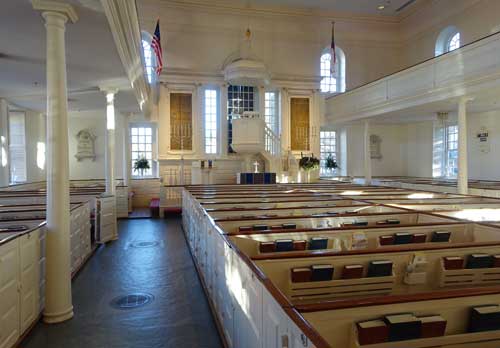
9. Christ Church in Alexandria
This is one of the most historic buildings in the Washington metro area, and a very active Episcopal church. The building was completed in 1773 and appears essentially the same as it did then, other than the steeple, which was finished in 1818. George Washington attended this church, and visitors can see his family's box pew. Robert E. Lee grew up only a few blocks away and he regularly attended services here until he left for West Point. A small plaque marks the spot on the front rail where he was confirmed into the church. Overall, the church is remarkably authentic and well preserved. Inside are two large painted plaques with the ten commandments and several prayers, which date from the 1770s and have never been retouched. On weekdays, Saturdays, and Sunday afternoons, docents are usually available to tell visitors about the history and architecture of the church.
Address: 118 N. Washington Street, Alexandria, VA 22314
Metro: King Street
Website: historicchristchurch.org
Photograph: © Peter R. Penczer 2015
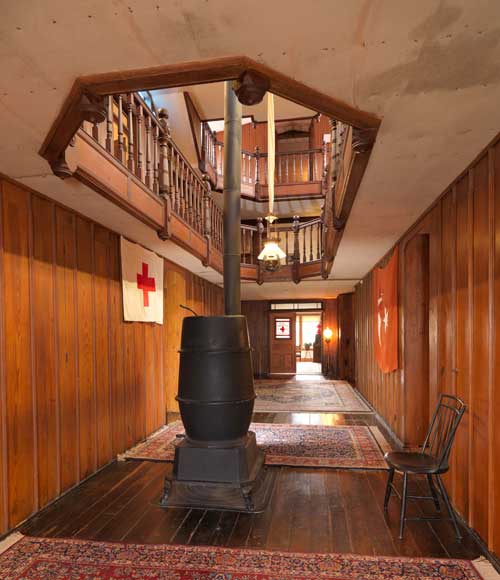
10. Clara Barton House (temporarily closed)
The Clara Barton House is interesting both for its unusual architecture and its connection to Clara Barton, founder of the American Red Cross. The 1891 structure is a rare example of the Arts and Crafts style in the Washington area, and an odd combination of office, private residence, and warehouse. The house was built for Barton and was originally used for the storage of relief supplies. In 1897, she moved into the house and lived there until she died in 1912. The structure became the headquarters for the Red Cross, and staff members lived there. Barton famously drew little distinction between her personal life and her role as president of the Red Cross, and the house reflects that.
The National Park Service now operates the house as a museum and offers free tours, although it is presently (as of 2018) closed to the public for a rehabilitation project. The interiors are restored to their appearance at the time when Barton lived there. The house is directly adjacent to Glen Echo Park, an arts and cultural center housed in the remains of an amusement park that closed in 1968. Glen Echo has art classes and studios, a carousel, dancing in the Spanish Ballroom, and much more. Some of the old amusement park structures have been restored and now serve the park's activities, while others are still in ruins.
Clara Barton National Historic Site
Address: 5801 Oxford Road, Glen Echo, MD 20812
Glen Echo Park
Address: 7300 MacArthur Boulevard, Glen Echo, MD 20812
Website: glenechopark.org
Metro: The Clara Barton house and Glen Echo are easiest to reach by car, but there is information on public transportation on the Glen Echo website.
Photograph: © Bruce M. White 2015. Capital Houses: Historic Residences of Washington, D.C. and its Environs, 1735-1965 by James M. Goode, photography by Bruce M. White.
Copyright © Peter R. Penczer 2018